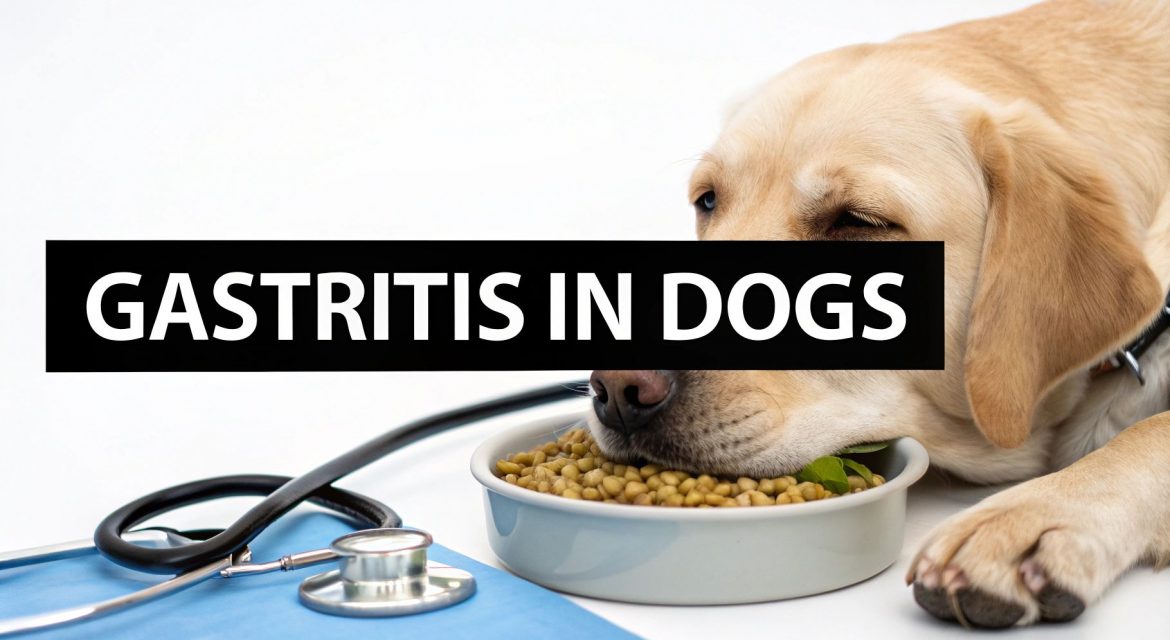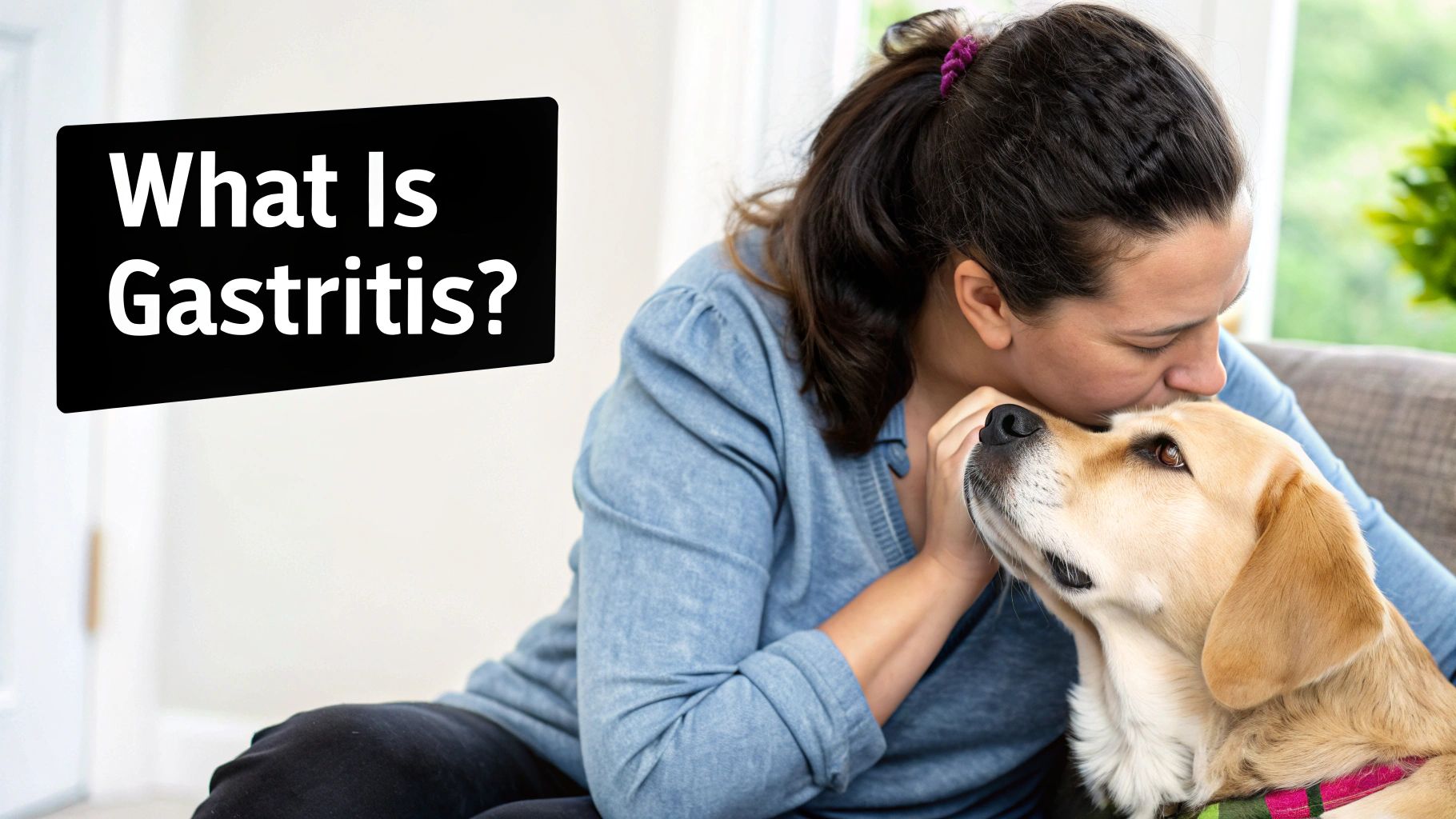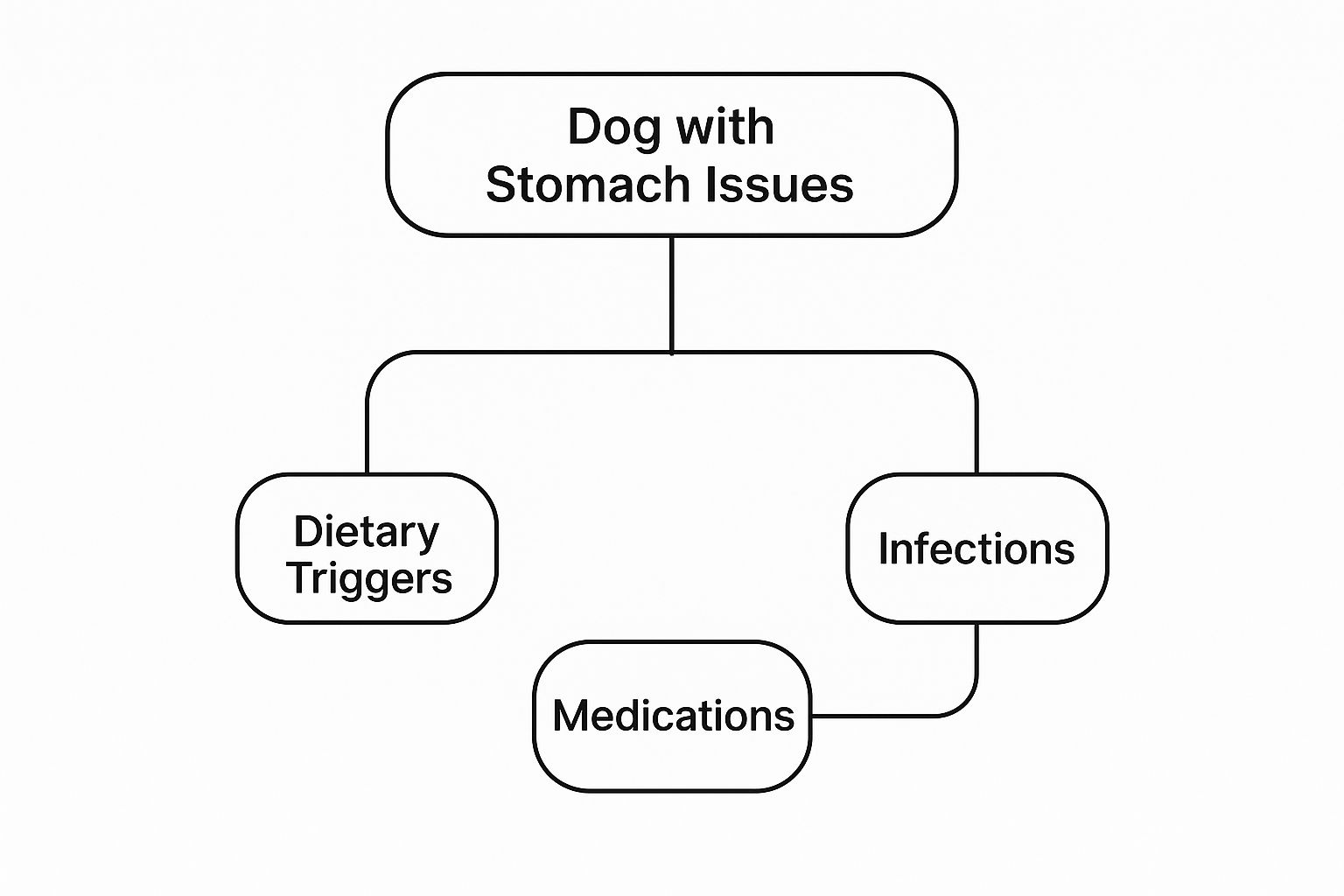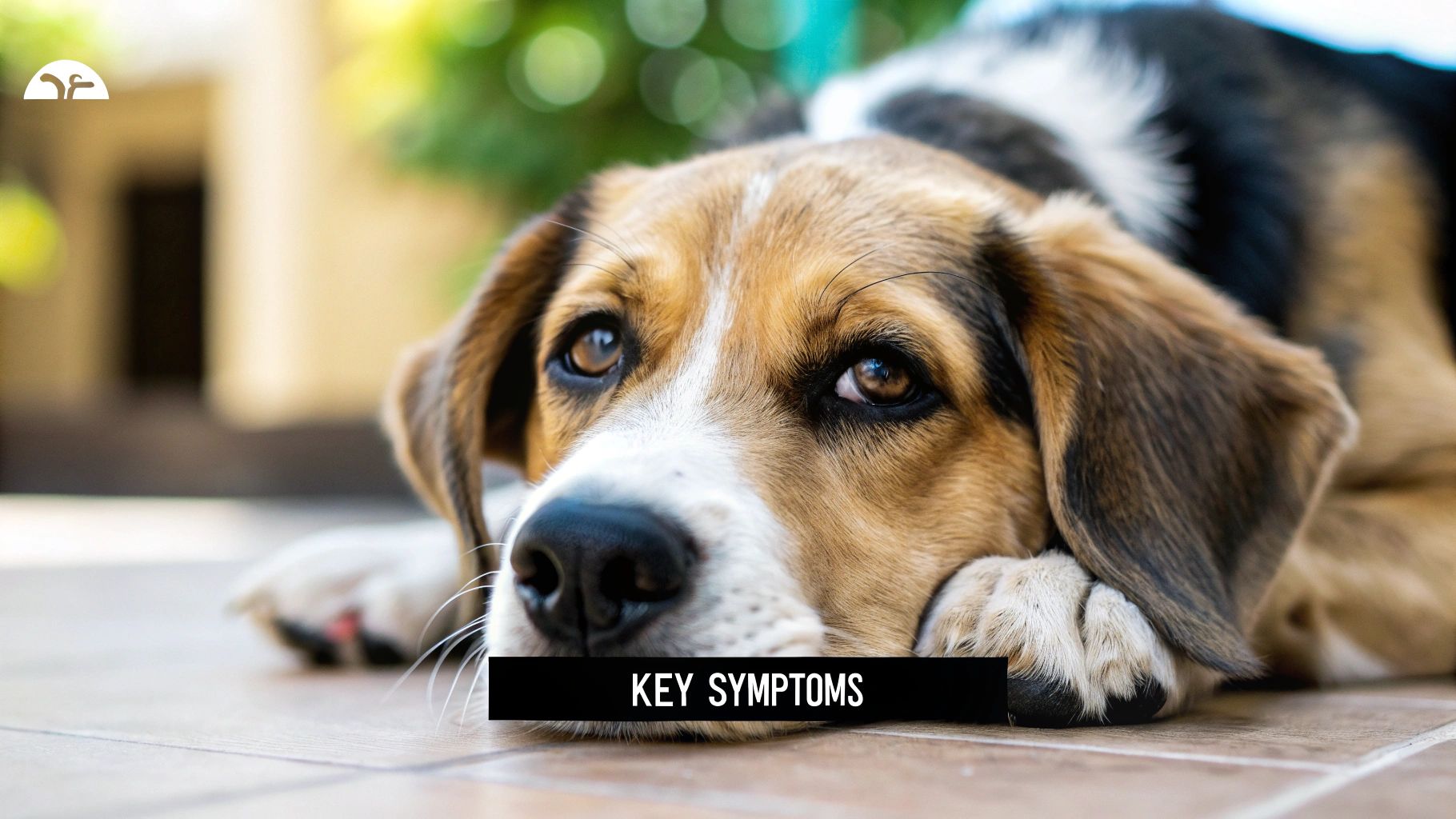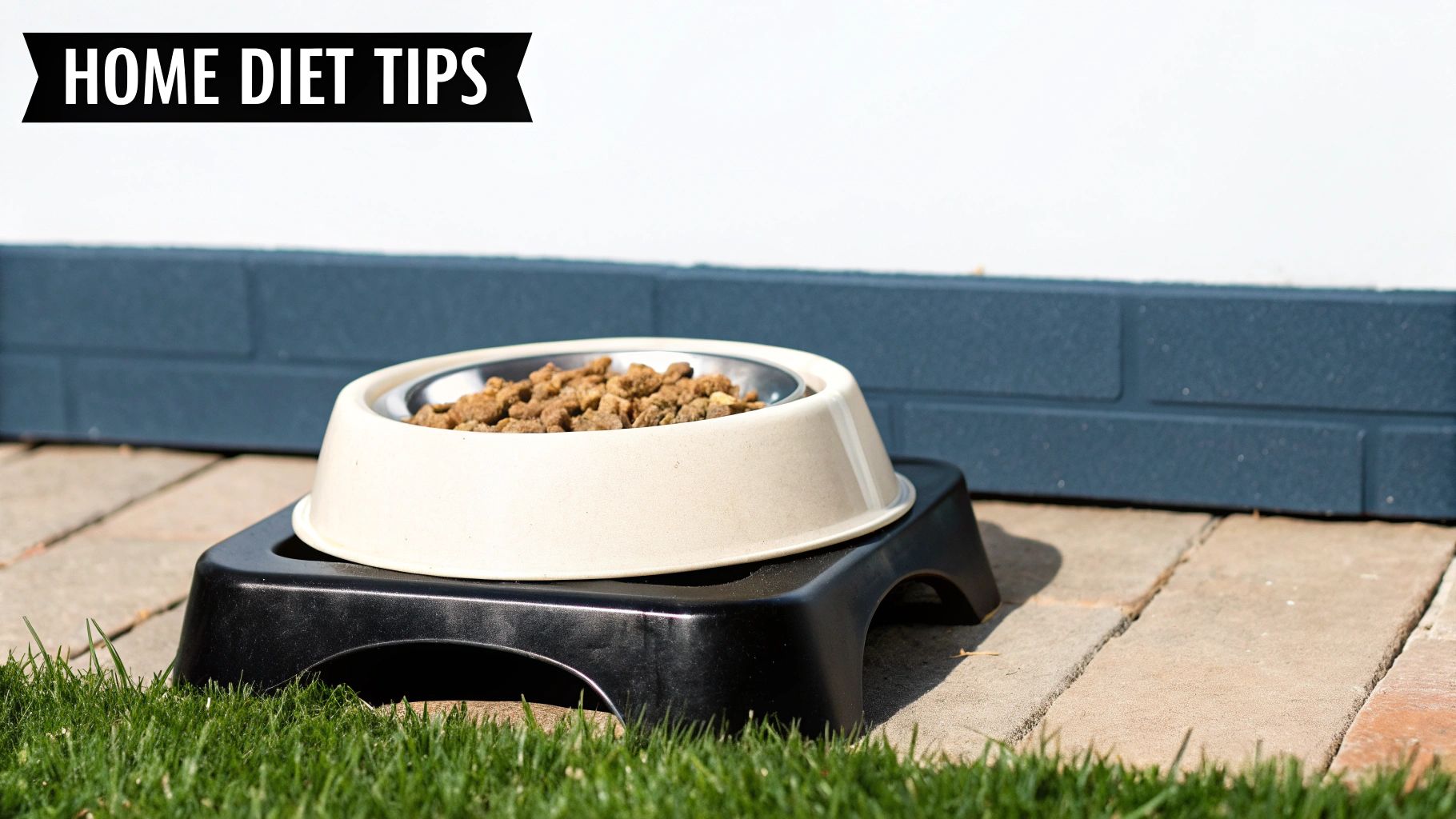It’s a sound that makes any dog owner's heart sink: that awful, unmistakable retching that tells you your dog is about to be sick. We’ve all been there. While a one-off upset stomach isn't usually a cause for panic, if it's happening a lot, you might be dealing with gastritis in dogs. Seeing your best friend feeling so poorly is horrible, but understanding what's going on is the first step to helping them. We're here to walk you through it.
What Is Gastritis in Dogs
At its heart, gastritis is simply an inflammation of your dog’s stomach lining. Picture it as a really sore, raw tummy. Something has irritated this delicate lining, causing it to swell up and become painful, which then triggers the vomiting and discomfort you're seeing. It’s tough to watch, we know.
When the stomach lining is inflamed, it can't do its job properly, making it hard for your dog to digest their food. Getting your head around this basic idea can make the whole situation feel a lot less overwhelming and put you in a better position to help.
Acute vs Chronic Gastritis
To figure out the best way forward, vets usually split gastritis into two types, based on how long the problem has been going on. This is a really important distinction for us to understand, as it shapes everything from diagnosis to treatment.
-
Acute Gastritis: This version appears out of nowhere and is usually over relatively quickly. It’s often the result of a single incident, like your dog raiding the bin or eating something questionable in the garden. With a bit of care, most dogs bounce back from acute gastritis in no time.
-
Chronic Gastritis: This is the long-haul version, where the inflammation drags on for weeks, months, or even longer. If your dog has chronic gastritis, it points to a deeper, ongoing issue that needs a proper investigation to get to the bottom of it.
You can think of it like this: acute gastritis is a sudden thunderstorm that rolls in and passes quickly. Chronic gastritis, on the other hand, is like that persistent grey, drizzly weather that just refuses to clear up. One is a brief disruption; the other signals a more stubborn problem we need to solve together.
Gastritis is one of the most common culprits behind sudden vomiting in dogs. While many cases are mild, knowing the difference between a simple upset tummy and a more persistent issue is vital for getting your companion the right help when they need it.
What Is Happening Inside Your Dog's Stomach
So, what’s actually going on in your dog's belly when gastritis flares up? The stomach is a pretty tough organ, lined with a special mucous layer that acts as a shield against its own powerful digestive acids. This barrier is crucial for healthy digestion.
But when something manages to irritate that protective lining—whether it’s gone-off food, a foreign object, or an underlying illness—the shield gets damaged. This breach allows stomach acid to make direct contact with the stomach wall itself, causing inflammation, pain, and that raw, sore feeling.
This internal turmoil is what kicks off the classic signs of gastritis, especially vomiting, as the stomach desperately tries to eject whatever is causing the trouble. It’s also why your dog might go off their food or seem lethargic; their body is pouring all its energy into dealing with the inflammation. Realising these are your dog's ways of telling you they’re in pain is the first step on their road to recovery.
Key Symptoms of Gastritis in Dogs
You know your dog better than anyone. You know their little quirks, their daily zoomies, and precisely how they look at you when the treat jar opens. This bond means you’re the first line of defence when something isn’t quite right. Trusting that gut feeling is crucial, and knowing the specific warning signs of gastritis will help you act quickly when it matters.
The symptoms can be glaringly obvious or surprisingly subtle. Let's break down what they actually look like, so you know exactly what to watch for.
As this shows, the trouble often starts with something your dog has ingested—whether it's a dietary slip-up, an infection, or even a reaction to medication.
The Most Common Signs
When a dog’s stomach is inflamed, their body has a few classic ways of sounding the alarm. The most unmistakable sign of gastritis is vomiting. This isn’t just a little bit of spit-up; we’re talking about repeated episodes that might contain undigested food, clear liquid, or yellowish bile.
Right alongside the vomiting, you’ll almost certainly see a sudden loss of appetite. A dog who usually dances for their dinner but now won’t even sniff their favourite food is sending a very clear message. This is often paired with lethargy—they might seem unusually tired, uninterested in walks, and just generally 'off'.
Subtle Clues to Look For
While vomiting is a major red flag, gastritis can also whisper its presence. Paying close attention to your dog’s body language can reveal a lot about how they're feeling.
A key subtle sign is abdominal pain. Since your dog can’t tell you their tummy hurts, they’ll show you. You might notice them:
- Adopting a hunched-over posture, almost as if they're trying to guard their belly.
- Standing in the "prayer position"—front legs on the floor, rear end in the air. This is a classic attempt to stretch out and relieve abdominal pressure.
- Showing sensitivity or yelping when you try to pick them up or touch their stomach.
Another clue is nausea, which often pops up before the vomiting starts. Signs of this can include excessive drooling, constant lip-licking, or swallowing repeatedly. You might even see them frantically eating grass, a common instinct dogs have to try and soothe their stomach or make themselves sick.
It's so important to recognise both the loud and quiet signals of gastritis. A change in posture can be just as telling as a bout of vomiting. It's all about seeing the complete picture of your dog's well-being.
When Symptoms Become Serious
Most cases of acute gastritis get better with a vet’s help, but it's vital to know when the situation demands immediate action. Sometimes, what seems like a simple upset stomach can escalate quickly.
When to Call the Vet: Symptoms at a Glance
This table is a quick reference guide to help you assess the severity of your dog's symptoms and decide on the next steps.
| Symptom | What It Looks Like | Action to Take |
|---|---|---|
| Occasional Vomiting | Vomiting once or twice but otherwise seems bright and active. | Monitor closely at home. If it continues for more than 24 hours, call your vet. |
| Abdominal Pain | Hunched posture, whining, restless, or yelps when their belly is touched. | Call your vet for advice. This indicates significant discomfort. |
| Vomiting Blood | Bright red streaks or dark, coffee ground-like material in the vomit. | Contact your vet immediately. This is an emergency. |
| Severe Lethargy | Unresponsive, weak, or has trouble standing up. | Seek emergency veterinary care right away. |
| Signs of Dehydration | Dry or sticky gums, sunken eyes, and a lack of skin elasticity. | This requires prompt veterinary intervention to correct. |
Knowing these distinctions helps you make the best call for your dog. If you're ever in doubt, it is always, always safer to err on the side of caution and get professional advice. Your peace of mind, and your dog’s health, are what matter most.
Common Causes of a Dog's Upset Stomach
It’s completely natural to ask, "How on earth did this happen?" when your dog is feeling under the weather. Getting to the bottom of what’s causing the gastritis is the first step towards getting them better and stopping it from happening again. We know how worrying it can be, so let’s walk through the most common culprits together.
Think of your dog's stomach as a normally balanced and happy place. Gastritis is what happens when something comes along and upsets that peace, causing the stomach lining to become inflamed. Often, the cause is surprisingly simple, but sometimes it can be a sign of something more serious going on.
Knowing what might be behind the upset will help you feel more prepared for your vet visit and more confident in protecting your dog's tummy in the future.
Dietary Indiscretion: The Usual Suspect
The most common reason for a sudden bout of gastritis has a rather official-sounding name: dietary indiscretion. Put simply, it just means your dog ate something they definitely shouldn’t have. Sound familiar? We’ve all been there.
This could be anything from snatching some fatty leftovers off the table to a more adventurous snack discovered in the bin or during a walk. Sometimes called "garbage gut," it's the classic case of a dog's curiosity leading them into trouble.
These forbidden treats can directly irritate the stomach lining, leading to a very swift and unhappy reaction. While it’s frustrating, the good news is that these episodes are usually the easiest to sort out once the offending item is out of their system.
When we see a sudden case of gastritis, the first question is almost always, "What could they have eaten?" A dog's powerful sense of smell can lead them to all sorts of trouble, from decomposing food in the park to a dropped snack on the pavement.
Infections and Pesky Parasites
Sometimes, the problem isn’t something your dog ate, but something that’s decided to move in. All sorts of unwelcome visitors can set up camp in their digestive system and lead to gastritis.
Bacterial or viral infections are common offenders. Bacteria like Salmonella or E. coli can cause some serious stomach upset, triggering the inflammation we know as gastritis. In the same way, certain viruses can attack the gastrointestinal tract.
We also have to think about internal parasites. Unwanted guests like giardia or roundworms can irritate the stomach and intestines, causing ongoing digestive problems that won't go away on their own. This is just one of the many reasons why regular parasite control is so vital for your dog's health.
Underlying Health Conditions and Medications
If the gastritis becomes a long-term problem or keeps flaring up, we need to dig a little deeper. Often, a persistent upset stomach is actually a symptom of another health issue happening elsewhere in your dog’s body.
Certain diseases can have a direct impact on the stomach. For instance, conditions like kidney or liver disease can cause toxins to build up in the bloodstream, which in turn irritates the stomach lining and leads to a specific type of gastritis.
On top of that, some medications can be tough on a dog's tummy. While often necessary, drugs like non-steroidal anti-inflammatory drugs (NSAIDs) can sometimes cause irritation as a side effect. It’s a delicate balance that your vet works hard to manage. If you’re ever worried about strange gurgling noises from your dog's stomach, which can sometimes come with these issues, it helps to understand what those sounds might mean. You can learn more about what your dog's stomach gurgling might be telling you in our detailed guide.
Finally, food allergies or intolerances can also be the root cause of chronic gastritis, creating a constant state of inflammation. Working out the specific trigger ingredient is the key to giving them long-term relief. In the UK, gastritis is frequently seen in veterinary clinics, often as part of acute gastroenteritis. Data shows the yearly prevalence of acute diarrhoea, a primary sign of gastritis, was about 3.8% among dogs in primary veterinary care in 2019, though the true figure is likely higher as many cases get recorded under the broader 'gastroenteritis' label. You can explore more on the prevalence of this condition in UK dogs.
How Vets Diagnose and Treat Gastritis
Walking into the vet clinic when you’re worried about your dog can be a nerve-wracking experience. We’ve all been there. Knowing what to expect can make the whole process feel less daunting, so let’s walk through it together. Think of this as a peek behind the curtain to understand why your vet does what they do to get your furry friend feeling better.
The first thing your vet will do is simply listen. You know your dog better than anyone, and your story is one of the most powerful diagnostic tools they have. Be ready to share details like when the symptoms started, what the vomit looks like, any recent changes to their diet, and whether your dog might have gobbled up something they shouldn’t have.
After a good chat, your vet will perform a thorough physical exam. They’ll gently feel your dog’s belly to check for pain or anything unusual, listen to their heart and lungs, and check their hydration by looking at their gums and skin. This hands-on check-up provides the first crucial clues.
Getting a Clearer Picture with Diagnostic Tests
To figure out exactly what’s going on inside your dog’s tummy, your vet will likely suggest a few tests. Each test is a piece of the puzzle, helping to rule out other issues and confirm if it’s gastritis we’re dealing with.
Common tests include:
- Blood Work: A complete blood count (CBC) and biochemistry panel are fantastic for spotting signs of infection, inflammation, or dehydration. They also give a snapshot of how well organs like the liver and kidneys are working, which is vital for ruling out other underlying diseases.
- Faecal Tests: A stool sample is often checked for internal parasites like giardia or roundworms. These unwelcome guests are a common cause of persistent stomach upset.
- X-rays or Ultrasound: If your vet suspects a blockage from a foreign object (like a sock or a toy) or a tumour, they’ll turn to imaging. X-rays are brilliant for spotting solid objects, while an ultrasound gives a detailed, real-time look at the stomach lining and other organs in the abdomen.
These tests help your vet build a complete picture of your dog’s health, ensuring they create the most effective treatment plan possible. Being informed about your dog's health is incredibly empowering, and for a broader overview, our guides on general dog health and care are a great resource.
Common Treatment Approaches
Once gastritis is confirmed, the goal is simple: make your dog feel better. The treatment plan is all about soothing that inflamed stomach, getting the symptoms under control, and tackling the root cause. Your vet will tailor everything to your dog's specific situation.
Supportive care is almost always the first and most important step. If your dog is dehydrated from all the vomiting, your vet will administer fluid therapy, either just under the skin (subcutaneously) or directly into a vein (intravenously). Getting your dog rehydrated is absolutely essential for their recovery.
Your vet will also likely prescribe medications to manage the symptoms and give the stomach a helping hand.
The main goals of treatment are to stop the vomiting, rehydrate the body, and give the stomach lining a chance to heal. By controlling the symptoms, we create the perfect environment for recovery.
Medications you might see include:
- Anti-nausea Drugs (Antiemetics): Medications like maropitant (Cerenia®) work wonders to control vomiting and nausea, bringing almost immediate relief to your dog.
- Stomach Protectants: Vets often prescribe what are known as ‘gastroprotectants’. These drugs either reduce stomach acid or coat the stomach lining, creating a protective shield that allows it to heal properly.
These stomach protectants are a mainstay of treatment. Here in the UK, it’s common for vets to prescribe medications like omeprazole for gastritis. In fact, one study found that in first-opinion vet practices, around 37.7% of dogs with acute diarrhoea—a classic sign of gastritis—were given gastrointestinal agents, including these protectants. It just goes to show how central they are to managing tummy troubles. You can read more about these veterinary prescribing practices and their role in getting dogs back on their feet.
Home Care and Diet for a Dog with Gastritis
Once your vet has laid out a treatment plan, your role at home becomes the absolute cornerstone of your dog's recovery. Seeing your companion finally start to feel better is a massive relief, and the supportive care you provide is what truly helps them turn that corner. We know you're ready to do whatever it takes, so think of this as your practical guide for nursing your dog back to full health.
The journey begins by creating a calm, healing environment. Your dog’s body is working overtime to repair itself, and proper rest is a non-negotiable part of that process.
The First Step: Resting the Stomach
Your vet will likely recommend withholding food for 12 to 24 hours. This can feel completely wrong, especially when your dog gives you those sad, hungry eyes, but it’s an incredibly important step. We get it, it’s tough.
Think of their inflamed stomach lining like a badly scraped knee. You wouldn't keep poking or rubbing it; you'd protect it so it could heal. Withholding food gives their digestive system a much-needed break from the hard work of digestion, allowing that angry inflammation to finally settle down.
During this brief fast, making sure they stay hydrated is your top priority. Always have fresh, clean water available. If they're drinking too much at once only to vomit it back up, try offering small amounts of water or even a few ice chips frequently instead.
Reintroducing Food Gently
After the fasting period is over—and with your vet’s green light—it's time to reintroduce food. The key here is to start with a bland, easily digestible diet that won’t put any strain on their still-sensitive stomach. You’re essentially rebooting their digestive system, so slow and steady is the way to go.
Simple, gentle foods are what you need. A few great options include:
- Boiled, boneless, skinless chicken or turkey, completely plain with absolutely no seasoning.
- Plain white rice, cooked until it’s soft and a little mushy.
- Plain canned pumpkin (make sure it's not the pie filling!), which is brilliant for soothing the stomach.
Start by offering a tiny portion, maybe just a spoonful, to see how their stomach reacts. If they keep it down without any issues, you can offer another small meal a few hours later. The "little and often" approach is your best friend here, as it stops their stomach from being overwhelmed.
The bland diet acts as a temporary bridge back to their normal food. It provides essential nutrients without asking the stomach to work too hard, giving the inflamed lining the peace and quiet it desperately needs to mend.
Creating a Healing Haven
Beyond their food bowl, your dog’s environment plays a huge part in their recovery. A quiet, comfortable resting spot away from the general hustle and bustle of the household will encourage them to properly relax.
Keep a close eye on their progress. You're looking for positive signs like a returning appetite, more energy, and an end to the vomiting. Make a note of any changes in their symptoms, stool consistency, and overall demeanour, as this information is incredibly valuable for your vet.
Gastrointestinal issues like gastritis are, unfortunately, quite common in dogs. Data from UK veterinary records shows that enteropathies (disorders of the intestines, which include gastritis) are a major health concern. One study reported a prevalence of 10.43% in dogs under primary vet care, making it one of the most frequent problems vets see, right up there with dental and skin issues.
As your dog continues to improve, you can slowly begin transitioning them back to their regular food over several days. Mix a small amount of their usual food into the bland diet, gradually increasing the ratio until they're fully back on their normal meals. This careful transition helps prevent any frustrating setbacks. For more guidance on their long-term dietary health, check out our in-depth article on mastering your dog's nutrition.
Still Got Questions About Gastritis in Dogs?
We’ve covered a lot of ground, from the causes and symptoms to diagnosis and treatment. Still, it's completely normal if you've got a few more questions buzzing around in your head. When you're worried about your dog, you want to be sure you have all the facts straight.
To help clear things up and give you a bit more peace of mind, we've pulled together some of the most common questions we hear from fellow dog owners. Let’s dive in.
Can I Give My Dog Human Medicine for an Upset Stomach?
This question always comes from a place of love, but the answer is a firm and absolute no. Reaching for your own medicine cabinet is one of the most dangerous mistakes you can make for your pet.
Many over-the-counter drugs we use, especially painkillers like ibuprofen or paracetamol, are incredibly toxic to dogs. They can cause catastrophic damage to their stomach lining, kidneys, and liver—sometimes with fatal results. Even something that seems harmless, like an antacid, could throw their digestive system out of balance or, worse, hide a serious problem that needs a vet's attention.
Your vet is the only person who can safely prescribe medication for your dog. They know which drugs are safe and the exact dose your companion needs. Please, never guess – always call a professional.
How Long Does Gastritis Last in Dogs?
How long it takes for a dog to recover from gastritis really hinges on what caused it and how bad it is. It’s a bit like us recovering from an illness—getting over a simple bug is a lot faster than bouncing back from a nasty infection.
For a straightforward case of acute gastritis, maybe where your dog just ate something they shouldn't have, you could see a massive improvement within 24 to 48 hours once they're getting the right care from the vet.
But if you're dealing with chronic gastritis, or if it’s caused by something more complex like an infection, food allergy, or another health condition, recovery will naturally take longer. In those cases, the focus shifts from just managing the symptoms to treating the root cause. Following your vet’s plan to the letter is the best way to get your dog back on their paws.
What's the Difference Between Gastritis and Gastroenteritis?
It's so easy to mix these two up. They sound almost identical and the symptoms can overlap, which causes a lot of confusion for owners. The key difference is simply where the inflammation is.
Let's break the words down—it actually makes it much clearer:
- Gastritis: 'Gastro' refers to the stomach, and '-itis' just means inflammation. So, gastritis is purely inflammation of the stomach lining. The main symptom you'll almost always see is vomiting.
- Gastroenteritis: This one has an extra bit: 'entero,' which refers to the intestines. So, gastroenteritis is inflammation of both the stomach and the intestines.
Because gastroenteritis involves the intestines too, you’ll usually see trouble at both ends. That means a dog will likely have both vomiting and diarrhoea. Your vet can pinpoint what’s going on based on your dog's specific symptoms, and knowing this little difference helps you give them a clearer picture, leading to a faster, better treatment plan.
At My Life My Dog, we're here to give you the clear, reliable information you need to look after your best mate with confidence. For more deep dives into everything from health and diet to training tips, pop over to https://mylifemydog.com.


